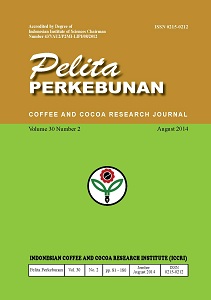Distribution of Soil Fertility of Smallholding Arabica Coffee Farms at Ijen-Raung Highland Areas Based on Altitude and Shade Trees

Main Article Content
Abstract
Soil fertility is one of the most important factors influencing plant growth and productivity and it depends on the availability and quantity of nutrients in the soil. To study soil fertility status of an area, a study on soil chemistry and physics has to be conducted. The aim of this study was to investigate soil fertility status of smallholding Arabica coffee farms based on altitude and shades trees utilization. This research was carried out in April-August 2012 at IjenRaung highland areas by field survey. The results showed that the soil contained high content of organic carbon, nitrogen total, and C/N ratio; low available phosphorus; moderate to high cation exchange capacity, and low base cation of calcium, magnesium, and potassium; as well as slightly low pH. Higher altitude tended to have higher C organic and N total content, C/N ratio as well as pH. In contrast, in lower altitude tended to have lower available P, base saturation, as well as Ca, Mg, and K content. The dominant shade trees for coffee farming at the Ijen-Raung highland areas were suren (Toona sureni) , dadap (Erythrina sp.), kayumanis (Cinnamomum zeylanicum), pinus (Pinus mercusii), and kayu putih (Eucalyptus globulus). Different shade tree species resulted in different of soil fertility. Shade trees tended to influence cation exchange capacity from moderate to high, pH slightly acid, high base saturation, and low P available. Suren tree influenced better base cation than that of other trees but dadap tree was better in increasing soil fertility. Key word: Soil fertility, arabica coffee, andisol, shade trees, smallholding
Article Details
How to Cite
Puspita sari, N., Iman Santoso, T., & Mawardi, S. (2013). Distribution of Soil Fertility of Smallholding Arabica Coffee Farms at Ijen-Raung Highland Areas Based on Altitude and Shade Trees. Pelita Perkebunan (a Coffee and Cocoa Research Journal), 29(2). https://doi.org/10.22302/iccri.jur.pelitaperkebunan.v29i2.57
Issue
Section
Articles

This work is licensed under a Creative Commons Attribution-NonCommercial 4.0 International License.
Authors who publish with this journal agree to the following terms:
- Authors retain copyright and grant the journal right of first publication with the work simultaneously licensed under a Creative Commons Attribution License that allows others to share the work with an acknowledgement of the work's authorship and initial publication in this journal.
- Authors are able to enter into separate, additional contractual arrangements for the non-exclusive distribution of the journal's published version of the work (e.g., post it to an institutional repository or publish it in a book), with an acknowledgement of its initial publication in this journal.
- Authors are permitted and encouraged to post their work online (e.g., in institutional repositories or on their website) prior to and during the submission process, as it can lead to productive exchanges, as well as earlier and greater citation of published work (See The Effect of Open Access).

